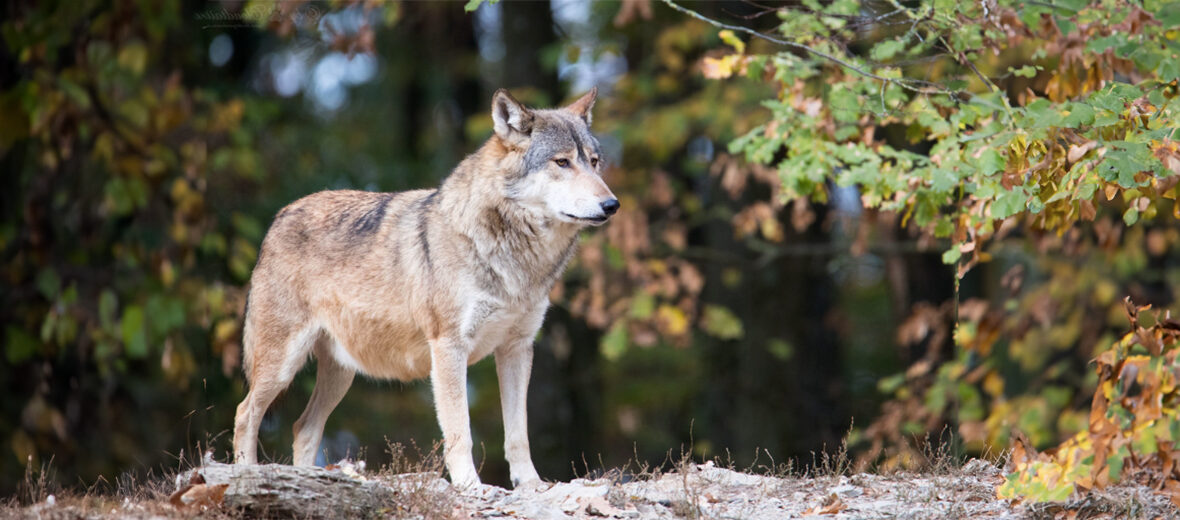
The eastern wolf, aka Algonquin wolf, timber wolf, or eastern timber wolf, is native to the Great Lakes region of the United States and southeastern Canada. They are thought of as either a subspecies of the grey wolf or red wolf and/or a separate species altogether. They face the threats of habitat loss and destruction at the hands of residential and commercial developments, hunting, and trapping. While not formally listed with the IUCN, they are listed as a Threatened species with the Endangered Species Act.
First the Stats…
Scientific name: Canis lycaon
Weight: Up to 284.4 lbs.
Length: Up to 5.5 feet
Height: Up to 36 inches, at the shoulders
Lifespan: Up to 15 years
Now on to the Facts!
1.) While there have been numerous studies that have declared the eastern wolf to be the product of ancient, as well as recent, genetic admixture (interbreeding) between the gray wolf and the coyote; other studies have declared these critters have separated from a common ancestor with the wolf over 1 million years ago.
2.) The common name for these wolves, Algonquin wolf, hails from Canada.
3.) There are 2 variants which differ in size. The larger being referred to as the Great Lakes wolf, and hails from Minnesota, Wisconsin, the Upper Peninsula of Michigan, southeastern Manitoba, and northern Ontario, and the smaller variant hailing from central and eastern Ontario, as well as southwestern Quebec.
4.) Beavers, moose, and white-tailed deer are their primary prey items. However, they are also able to take down grizzly bears.
5.) Gray wolves including the timber wolf are protected under the Endangered Species Act of 1973, however these protections were later removed at the federal level in 2021 before being reinstated in 2022.
But wait, there’s more on the eastern wolf!
6.) Within Canada, the eastern wolf has been listed as Canis lupus lycaon under the Species At Risk Act 2002, Schedule 1 – List of Wildlife at Risk.
7.) These wolves were first described in 1775 by the German naturalist Johann Schreber.
Did you know…?
Hybridization often occurs with coyotes, which thins out the original species line and further reduces their true numbers.
8.) Among the earliest Canis specimens that were discovered at Cripple Creek Sump, Fairbanks, Alaska, in strata dated 810,000 years old. The dental measurements of the specimens definitely matched historical Canis lycaon specimens found in Minnesota.
9.) Pack territories can range up to 71 square miles, with packs taking extra precautions to stay away from one another.
10.) Early European settlers typically kept their livestock on eastern wolf-free outer islands. However, the livestock kept on the mainland were so subjected to predation that a joint settler and Native American effort was carried out to hunt down the eastern wolf in an effort to protect their livestock.
But wait, there’s still more on the eastern wolf!
11.) These wolves are proudly portrayed in Algonquin mythology, where they are referred to as ma-hei-gan or nah-poo-tee in the Algonquian languages. They are considered the spirit brother of the Algonquian folk hero Nanabozho, and even assisted him in several of his adventures, including the thwarting of the plots of the malicious anamakqui spirits, and assisted him in recreating the world after a worldwide flood.
12.) In 1963 it was discovered that eastern wolves would answer human imitations of their howls, Algonquin Provincial Park began a Public Wolf Howls attraction, where as many as 2,500 visitors are taken on an trek into areas where eastern wolves were sighted the night before to listen to them answering the park staff’s imitation howls.
Did you know…?
Wolves, contrary to popular belief, do not howl at the moon. They howl to aid in locating each other. It just so happens that howling sometimes takes place on moonlit nights, containing a full moon.
13.) By 2000, an estimated 85 Public Wolf Howls had been participated in, with over 110,000 people having engaged in the attraction. The park considers this event as the cornerstone of its wolf education program and credits it with altering the public’s perception towards wolves in Ontario.
14.) Since the early 1970s, there have been numerous incidents of brazen or even aggressive behavior towards humans in Algonquin Provincial Park. Between 1987 – 1996, there were 4 records of wolves biting people.
15.) In 1998 a male wolf who had been long noted to be unphased by humans stalked a couple walking their 4-year-old daughter in September that year, eventualy losing interest when the family took refuge in a trailer. 2 days later, the same wolf attacked a 19-month-old boy, causing several puncture wounds on his back and chest before being chased off by campers. Later the animal was killed the same day, and was found to not be infected with rabies.
But wait, there’s still a little more on the eastern wolf!
16.) Females undergo up to a 63 day gestation (pregnancy) that yields up to 6 pups.
17.) Pups are weaned in up to 77 days.
Did you know…?
The most common diseases eastern wolves, or wolves in general can have are rabies, canine distemper, canine parvovirus, infectious canine hepatitis, papillomatosis, and canine coronavirus.
18.) The bite force of a wolf can be up to 400 lbs. per square inch!
19.) Eastern wolves have 42 teeth.
20.) Packs can contain up to 6 individuals.
Now a Short Eastern Wolf Video!
This video talks about the timber wolf.
Be sure to share & comment below! Also, check out the Critter Science YouTube channel. Videos added regularly!
Want to suggest a critter for me to write about? Let me know here.
Some source material acquired from: Wikipedia & IUCN
Photo credit: iNaturalist




